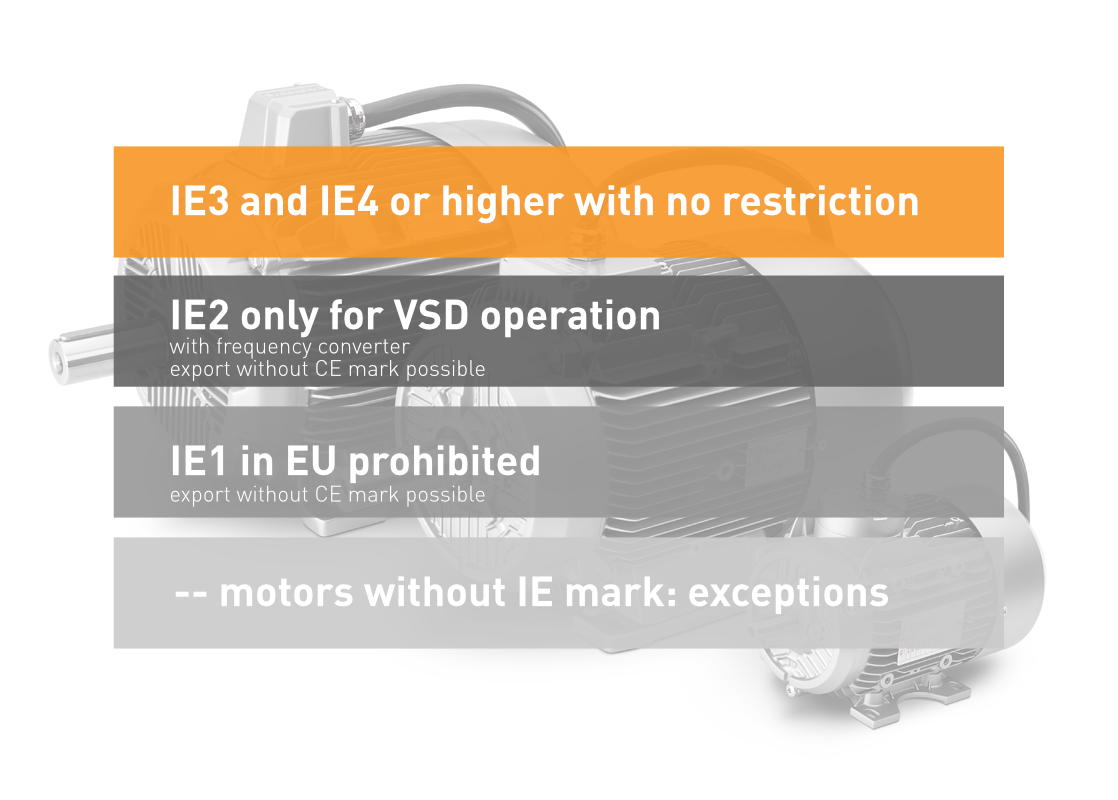
In accordance with Commission Regulation (EC) No 640/2009 and Directive 2009/125/EC, along with the standard ČSN EN (IEC) 6034, requirements for the efficiency of electric motors have been introduced. Commission Regulation (EC) 640/2009 was amended as at 6 January 2014 by Commission Regulation (EU) 4/2014 (this change came into force on 27 July 2014). Here is a list of the most frequently asked questions about the efficiency of electric motors:


Motor efficiency is essentially the same as the efficiency indicated, for example, for refrigerators or washing machines (in other words, energy efficiency). A similar system is also used to indicate the efficiency of electric motors. Previously the designations of the international association CEMEP were used. There were basically only 2 classification, EFF2 (increased efficiency) and EFF1 (high efficiency). Today, a new marking system is in use according to the European standard EN60034-30.
Numerous non-EU countries (such as Turkey and China) have also made the commitment to respect the directive. On the American continent, comparable rules apply (NEMA Energy and NEMA Premium).
The standard also defines the methodology for control measurements and requirements for the technical documentation of the motors themselves and the devices into which the motors are built.
The return on an investment in an energy-efficient motor depends on a multitude of circumstances, such as the operating time, real load, power supply, or energy supplier response to lower electricity consumption due to the mass deployment of efficient drives. The increased input costs can pay for themselves within a year or even a few months, especially where performance is higher and daily operations are longer.
According to the directive, equipment manufacturers should use electric motors delivering increased efficiency. Specifically:
“Many motors are integrated in other products without being separately placed on the market or put into service in the meaning of Article 5 of Directive 2005/32/EC and of Directive 2006/42/EC of the European Parliament and of the Council (2). To achieve the full cost-efficient energy saving potential, motors integrated in other products should be subject to the provisions of this Regulation.”
The text of the directive also states that this rule does not apply to: “motors completely integrated into a product (for example gear, pump, fan or compressor) of which the energy performance cannot be tested independently from the product”.
Unfortunately, this definition is rather vague and has been the subject of many disputes. All we can say with certainty is that only built-in electric motors without their own frame (an example here would be fully built-in electric motors in submersible pumps – they cannot be put into operation unless they are integrated and their efficiency outside of the equipment cannot be measured) can be regarded as “motors completely integrated into a product”. For other standard-design engines (in their own body – frame), energy efficiency can be measured.
Therefore, we recommended that equipment manufacturers carefully check the situation before ordering drives in order to avoid potential problems.
We currently offer electric motors in all efficiency classes (IE1, IE2, IE3 and IE4), as well as exempted motors with no efficiency designation.
Our e-shop categories are structured so you can choose an electric motor according to your efficiency requirements. You need to make sure that the use of electric motors in the IE1 and IE2 efficiency classes is limited to the territory of the EU.
No. The odd exception apart, new high-efficiency motors are delivered in dimensions and performance parameters identical to “old” motors. This means that, at the individual axial heights, there are no significant changes in the connecting dimensions (shaft diameters and lengths, and footing and flange pitch).